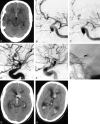Early rebleeding after coiling of ruptured cerebral aneurysms: incidence, morbidity, and risk factors
- PMID: 16091523
- PMCID: PMC7975140
Early rebleeding after coiling of ruptured cerebral aneurysms: incidence, morbidity, and risk factors
Abstract
Background and purpose: The purpose of this study was to assess the incidence of early rebleeding after coiling of a ruptured cerebral aneurysm, assess the clinical outcome, and identify risk factors for this event.
Methods: Early rebleedings occurred in 6/431 (1.4%) consecutive patients after coiling of a ruptured aneurysm. Clinical condition at the time of treatment, aneurysm location and size, initial aneurysm occlusion, timing of coiling, and the presence of an adjacent intracerebral hematoma in the six patients with early rebleedings were compared with the remaining 425 patients.
Results: Incidence of early rebleeding after coiling of a ruptured aneurysm was 1.4%, and mortality was 100%. Independent risk factors are the presence of an adjacent intracerebral hematoma and small aneurysm size. Dependent risk factors are location on the anterior communicating artery, initial incomplete aneurysm occlusion, and poor clinical condition at the time of treatment.
Conclusion: Early rebleeding after coiling of ruptured aneurysms is a major concern, in particular because the mortality is very high. A more restricted postembolization anticoagulation strategy in high-risk aneurysms may possibly prevent the occurrence of this devastating event.
Figures


References
-
- Brilstra EH, Rinkel GJ, van der Graaf Y, et al. Treatment of intracranial aneurysms by embolization with coils: a systematic review. Stroke 1999;30:470–476 - PubMed
-
- Molyneux A, Kerr R, Stratton I, et al. International Subarachnoid Aneurysm Trial (ISAT) of neurosurgical clipping versus endovascular coiling in 2143 patients with ruptured intracranial aneurysms: a randomised trial. Lancet 2002;360:1267–1274 - PubMed
-
- Sluzewski M, van Rooij WJ, Rinkel GJ, Wijnalda D. Endovascular treatment of ruptured intracranial aneurysms with detachable coils: long-term clinical and serial angiographic results. Radiology 2003;227:720–724 - PubMed
-
- Vanninen R, Koivisto T, Saari T, et al. Ruptured intracranial aneurysms: acute endovascular treatment with electrolytically detachable coils: a prospective randomized study. Radiology 1999;211:325–336 - PubMed
-
- Hunt WE, Hess RM. Surgical risk as related to time of intervention in the repair of intracranial aneurysms. J Neurosurg 1968;28:14–20 - PubMed
MeSH terms
LinkOut - more resources
Full Text Sources
Medical
